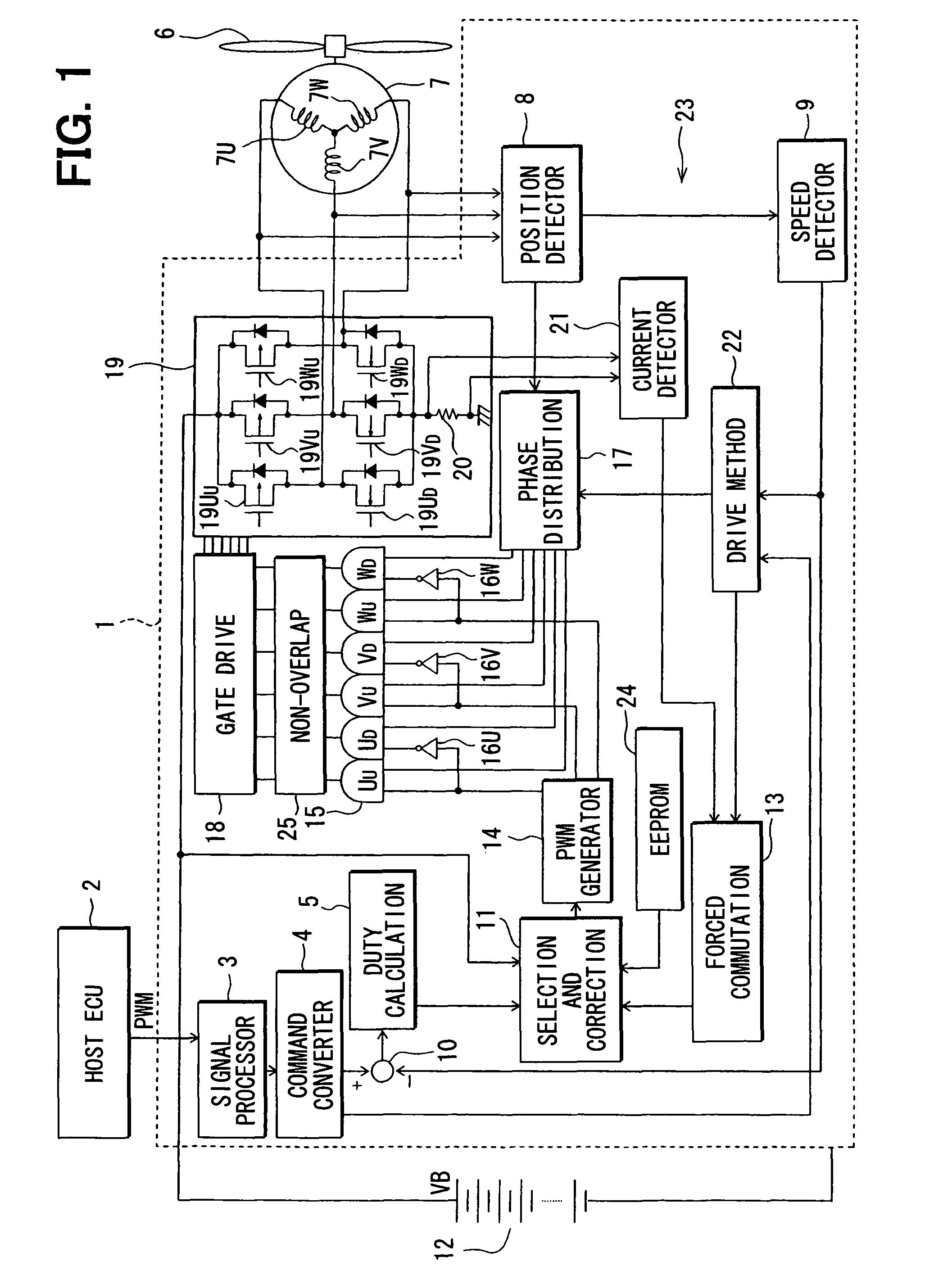Motor control apparatus, vehicle fan drive apparatus, and motor control method
a motor control and motor control technology, applied in the direction of electronic commutation motor control, motor/generator/converter stopper, dynamo-electric converter control, etc., can solve the problem of reducing the developed torque, large difference between the highest and lowest operating environment temperatures, and large flow in the motor
- Summary
- Abstract
- Description
- Claims
- Application Information
AI Technical Summary
Benefits of technology
Problems solved by technology
Method used
Image
Examples
first embodiment
[0042]Referring first to FIG. 1 showing a first embodiment, a motor control apparatus is configured as a fan drive apparatus 1 for driving a fan motor 7 mounted in a vehicle by energizing or exciting the fan motor 7 under a PWM control. The fan motor 7 is a three-phase brushless DC motor. Upon receiving a rotation speed command of a fan which is supplied as a PWM signal from a host control unit 2 such as a host ECU (electronic control unit), the fan drive apparatus 1 converts the PWM signal after signal processing by a signal processor circuit 3 into a voltage signal corresponding to the duty of the PWM signal, and outputs the voltage signal to a rotation speed command converter circuit 4. Upon receiving output signals from, for example, a water temperature sensor (NOt shown) that detects a water temperature within a radiator, or a vehicle speed sensor that detects the vehicle speed, the host control unit 2 outputs the rotation speed command according to those detection results.
[004...
second embodiment
[0070]The second embodiment may be configured in the similar manner as the first embodiment. In this embodiment, however, the current detector circuit 21 is used additionally in comparison to the first embodiment. As shown in FIG. 5 corresponding to FIG. 2, when the rotor is positioned with the DC energization in S5, the duty command selection circuit 11 detects an actual current value that flows in the shunt resistor 20 in this situation through the current detector circuit 21 (S11). Then, the voltage amplitude (maximum) of the pseudo sinusoidal wave which is a start drive signal is variably set according to the amplitude of the current value.
[0071]That is, since the resistance of the winding wires of the motor 7 changes according to the ambient temperature, the current reflects the winding resistance at that time according to the voltage that is applied to the winding wires at the time of positioning. Accordingly, when the voltage amplitude of the start drive signal is set accordi...
third embodiment
[0072]The third embodiment may be configured in the similar manner as the first embodiment. In the third embodiment, however, the voltage of the start drive signal is gradually increased (S14). That is, the maximum of the amplitude that changes in the sinusoidal configuration increases every time S14 is executed. For example, the maximum is increased by each 1% of the upper limit until reaching the upper limit of the applied voltage. With the above configuration, it is possible to start the motor more smoothly and surely.
PUM
 Login to View More
Login to View More Abstract
Description
Claims
Application Information
 Login to View More
Login to View More - R&D
- Intellectual Property
- Life Sciences
- Materials
- Tech Scout
- Unparalleled Data Quality
- Higher Quality Content
- 60% Fewer Hallucinations
Browse by: Latest US Patents, China's latest patents, Technical Efficacy Thesaurus, Application Domain, Technology Topic, Popular Technical Reports.
© 2025 PatSnap. All rights reserved.Legal|Privacy policy|Modern Slavery Act Transparency Statement|Sitemap|About US| Contact US: help@patsnap.com



